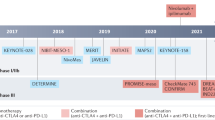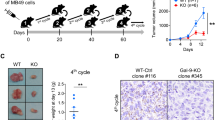Abstract
Malignant mesothelioma (MM) is a lethal tumor linked with a prior exposure to asbestos in which limited progress has been made so far using conventional therapies. MM is an example of a “nonimmunogenic” tumor characterized by a fibrous stroma and an absence of infiltrating T lymphocytes. High levels of transforming growth factor-beta (TGF-β) produced by mesothelioma cells have been related to the immune tolerance towards the tumor. In order to evaluate the effect of local delivery of cytokines such as interferon gamma (IFN-γ) by gene transfer, we characterized and used a murine model, AK7, which appeared very similar to human mesothelioma. AK7 cells expressed low levels of major histocompatibility class I and class II antigens and secreted high levels of latent TGF-β. The TGF-β pathway in AK7 cells is operative but inefficient because endogenous TGF-β is predominantly inactive. Treatment of pre-established AK7 tumors by direct intratumoral injection of an adenovirus vector expressing murine IFN-γ, Ad.mIFN-γ, led to significant tumor regression. Peripheral tumor infiltration by CD4+ and CD8+ T lymphocytes in the treated tumors appeared to be because of the induction of an immune response. Tumor relapse was observed, which could be due to local TGF-β secretion by remaining tumor cells.
This is a preview of subscription content, access via your institution
Access options
Subscribe to this journal
Receive 12 print issues and online access
$259.00 per year
only $21.58 per issue
Buy this article
- Purchase on Springer Link
- Instant access to full article PDF
Prices may be subject to local taxes which are calculated during checkout







Similar content being viewed by others
References
Wagner JC, Sleggs CA, Marchand P . Diffuse pleural mesothelioma and asbestos exposure in North Western Cape Province. Br J Ind Med. 1960;17:260–271.
Craighead JE, Mossman BT . The pathogenesis of asbestos-associated diseases. N Eng J Med. 1982;306:1446–1455.
Sterman DH, Kaiser LR, Albeida SM . Gene therapy for malignant pleural mesothelioma. Hematol Oncol Clin North Am. 1998;12:553–568.
Ramael M, Van Meerbeeck JV, Van Marck EV . Mesothelioma, currents insights. Cancer J. 1994;7:174–180.
Kumar-Singh S, Weyler J, Martin MJH, et al. Angiogenic cytokines in mesothelioma: a study of VEGF, FGF-1 and -2, and TGFβ expression. J Pathol. 1999;189:72–78.
Ruffie PA . Pleural mesothelioma. Curr Opin Onc. 1991;3:328–334.
Peto J, Hodgson JT, Matthews FE, Jones JR . Continuing increase in mesothelioma mortality in britain. Lancet. 1995;345:535–539.
Ulloa L, Doody J, Massague J . Inhibition of transforming growth factor-β/SMAD signalling by the interferon-gamma/STAT pathway. Nature. 1999;397:710–713.
Caminschi I, Venetsanakos E, Leong CC, et al. Cytokine gene therapy of mesothelioma. Immune and antitumoral effects of transfected interleukin-12. Am J Respir Cell Mol Biol. 1999;21:347–356.
Law MR, Hodson ME, Heard BE . Malignant mesothelioma of the pleura: relation between histological type and clinical behaviour. Thorax. 1982;37:810–815.
Graham FL, Van Der Eb EJ . A new technique for the assay of infectivity of human adenovirus 5 DNA. Virology. 1973;52:456–467.
Graham FL, Smiley J, Russel WC, Nairu R . Characteristics of a human cell line transformed by the DNA from human adenovirus 5. J Gen Virol. 1977;36:59–72.
Cordier L, Duffour MT, Sabourin JC, et al. Complete recovery of mice from a pre-established tumor by direct intratumoral delivery of an adenovirus vector harboring the murine IL-2 gene. Gene Ther. 1995;2:16–21.
Josien R, Douillard P, Guillot C, et al. A critical role for transforming growth factor-β in donor transfusion-induced allograft tolerance. J Clin Invest. 1998;102:1920–1926.
Monti G, Jaurand MC, Monnet I, et al. Intrapleural production of interleukin 6 during mesothelioma and its modulation by γ-interferon treatment. Cancer Res. 1994;54:4419–4423.
Fernandez N, Levraud JP, Haddada H, et al. High frequency of specific CD8+ T cells in the tumor and blood is associated with efficient local Il-12 therapy of cancer. J Immunol. 1999;162:609–617.
Baratin M, Ziol M, Romieu R, et al. Regression of primary hepatocarcinoma in cancer-prone transgenic mice by local interferon-gamma delivery is associated with macrophages recruitment and nitric oxide production. Cancer Gene Ther. 2001;8:193–202.
Johansson L, Linden CJ . Aspects of histopathologic subtype as a prognostic factor in 785 pleural mesotheliomas. Chest. 1996;109:109–114.
Barrack ER . TGF beta in prostate cancer: a growth inhibitor that can enhance tumorigenicity. Prostate. 1997;31:61–70.
Addison CL, Braciak T, Raltson R, et al. Intratumoral injection of an adenovirus expressing interleukin 2 induces regression and immunity in a murine breast cancer model. Proc Natl Acad Sci USA. 1995;92:8522–8526.
Wallach D, Fellous M, Revel M . Preferential effect of interferon-gamma on the synthesis of HLA antigens and their mRNAs in human cells. Nature. 1982;299:833–836.
Rosa F, Hatat D, Abadie A, et al. Differential regulation of HLA-DR mRNAs and cell surface antigens by interferon. EMBO J. 1983;2:1585–1589.
Collins T, Korman AJ, Wake CT, et al. Immune interferon activates multiple class II major histocompatibility complex genes and the associated invariant chain gene in human endothelial cells and dermal fibroblasts. Proc Natl Acad Sci USA. 1984;81:4917–4921.
Odaka M, Sterman DH, Wiewrodt R, et al. Eradication of peritoneal and distant tumor by adenovirus-mediated interferon-β gene therapy is attributable to induction of systemic immunity. Cancer Res. 2001;61:6201–6212.
Gerwin BI, Lechner JF, Reddel RR, et al. Comparison of production of transforming growth factor-B and platelet-derived growth factor by normal human mesothelioma cells and mesothelioma cell lines. Cancer Res. 1987;47:6180–6184.
Fitzpatrick DR, Bielefeld-Ohmann H, Himbeck RP, et al. Transforming growth factor-beta: antisense RNA-mediated inhibition affects anchorage-independent growth, tumorigenicity and tumor-infiltrating T-cells in malignant mesothelioma. Growth Factors. 1994;11:29–44.
Torre-Amione G, Beauchamp RD, Koeppen H, et al. A highly immunogenic tumor transfected with a murine transforming growth factor type β1 cDNA escapes immune surveillance. Proc Natl Acad Sci USA. 1990;87:1486–1490.
Vodovotz Y, Bogdan C, Paik J, et al. Mechanisms of suppression of macrophage nitric oxide release by transforming growth factor B. J Exp Med. 1993;178:605–613.
Bielefeldt-Ohmann H, Fitzpatrick DR, Marzo AL, et al. Patho- and immunobiology of malignant mesothelioma: characterisation of tumor infiltrating leucocytes and cytokine production in a murine model. Cancer Immunol Immunother. 1994;39:347–359.
Serve H, Steinhauser G, Oberberg D, et al. Studies on the interaction between interleukin 6 and human malignant nonhematopoietic cell lines. Cancer Res. 1991;51:3862–3866.
Higashihara M, Sunaga S, Tange T, et al. Increased secretion of interleukin-6 in malignant mesothelioma cells from a patient with marked thrombocytosis. Cancer. 1992;70:2105–2108.
Schmitter D, Lauber B, Fagg B, et al. Hematopoietic growth factors secreted by seven human pleural mesothelioma cell lines: interleukin-6 production as a common feature. Int J Cancer. 1992;51:296–301.
Bielefeldt-Ohmann H, Marzo AL, Himbeck RP, et al. Interleukin-6 involvement in mesothelioma pathobiology: inhibition by interferon γ immunotherapy. Cancer Immunol Immunother. 1995;40:241–250.
Walker C, Everitt J, Ferriola PC, et al. Autocrine growth stimulation by transforming growth factor a in asbestos-transformed rat mesothelioma cells. Cancer Res. 1995;55:530–536.
Versnel MA, Claesson-Welsh L, Hammacher A, et al. Human malignant mesothelioma cell lines express PDGF B-receptors whereas cultured normal mesothelioma cells express predominantly PDGF α-receptors. Oncogene. 1991;6:2005–2011.
Smythe WR, Kaiser LR, Hwang HC, et al. Successful adenovirus-mediated gene transfer in an in vivo model of human malignant mesothelioma. Ann Thorac Surg. 1994;57:1395–401.
Boylan AM, Sanan DA, Sheppard D, et al. Vitronectin enhances internalization of crocidolite asbestos by rabbit pleural mesothelial cells via the integrin alpha v beta 5. J Clin Invest. 1995;96:1987–2001.
Smythe WR, Hwang HC, Elshami AA, et al. Treatment of experimental human mesothelioma using adenovirus transfer of the herpes simplex thymidine kinase gene. Ann Surg. 1995;222:78–86.
Hwang HC, Smythe WR, Elshami AA, et al. Gene therapy using adenovirus carrying the herpes simplex-thymidine kinase gene to treat in vivo models of human malignant mesothelioma and lung cancer. Am J Resp Cell Mol Biol. 1995;13:7–16.
Kucharczuck JC, Elshami AA, Zhang HB, et al. Pleural-based mesothelioma in immune competent rats: a model to study adenoviral gene transfer. Ann Thorac Surg. 1995;60:593–598.
Elshami AA, Kucharczu JC, Zhang HB, et al. Treatment of pleural mesothelioma in an immunocompetent rat model utilizing adenoviral transfer of the herpes simplex virus thymidine kinase gene. Hum Gene Ther. 1996;7:141–148.
Boulanger P . Cell receptors for human adenoviruses. J Soc Biol. 1999;193:77–84.
Acknowledgements
This work was supported by the CNRS, the Association pour la Recherche sur le Cancer (ARC), the Ligue Nationale Contre le Cancer, the Institut Gustave Roussy, the Assistance pubique-hopitaux de Paris (AP-HP), the Fondation pour la recherche médicale (FRM) (LV), and by a research grant (RO1 ES 03189) from the National Institute of Environmental Health Sciences (AK). MAA had a MRC fellowship. We thank Patrice Ardouin and all the staff of the laboratory of animal experimentation (IGR), Jean-Pierre Levraud for providing oligonucleotides and his help for PCR analysis and Professor CH Heldin for providing the antibodies specific to Smad7 and phosphorylated Smad2. We also thank Dr J Dando and Professor Zaghouani for corrections of the manuscript. We are grateful to the Vector Core of the University Hospital of Nantes supported by the Association Française contre les Myopathies (AFM) for providing the Ad.TGFβ vector.
LCK present address: cell genesys, Inc, South San Francisco, CA 94080, USA
Author information
Authors and Affiliations
Corresponding author
Rights and permissions
About this article
Cite this article
Cordier Kellerman, L., Valeyrie, L., Fernandez, N. et al. Regression of AK7 malignant mesothelioma established in immunocompetent mice following intratumoral gene transfer of interferon gamma. Cancer Gene Ther 10, 481–490 (2003). https://doi.org/10.1038/sj.cgt.7700594
Received:
Published:
Issue Date:
DOI: https://doi.org/10.1038/sj.cgt.7700594
Keywords
This article is cited by
-
Absence of calretinin protein expression in malignant mesotheliomas from asbestos-exposed NF2+/− mice and mouse mesothelioma cell lines from various mouse strains
Biomarker Research (2018)
-
Establishment of immortalized murine mesothelial cells and a novel mesothelioma cell line
In Vitro Cellular & Developmental Biology - Animal (2015)
-
Gene therapy in interventional pulmonology: Interferon gene delivery with focus on thoracic malignancies
Current Respiratory Care Reports (2012)
-
Kinetics of Host Cell Recruitment During Dissemination of Diffuse Malignant Peritoneal Mesothelioma
Cancer Microenvironment (2011)
-
Vaccination with an adenoviral vector expressing calreticulin-human papillomavirus 16 E7 fusion protein eradicates E7 expressing established tumors in mice
Cancer Immunology, Immunotherapy (2007)



